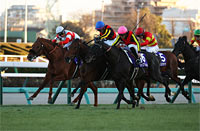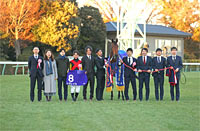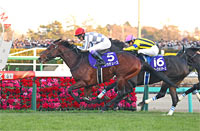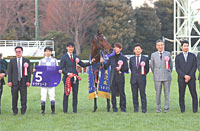Arima Kinen (The Grand Prix) (G1) - Comments from runners' connections

Aerolithe
Takanori Kikuzawa, trainer
“Almond Eye was really strong in the Tenno Sho (Autumn), but in the final stage this horse even tried to get past the eventual runnerup. She really did her best up against strong male horses. I gave her a bit of time off after that and she returned to the training center on Nov. 29. The race didn’t have any great impact on her. On Dec. 12, I worked her alone when there weren’t many other horses out and working to the right with four turns, she changed leads smoothly and moved well. There’s more time between races then there was going in to the Tenno Sho, so I’m able to get her ready a bit more slowly. She has won racing to the right and she’s been competitive against strong horses, so she should be fine this time too. If she can run her race, I think she can do well over 2,500 meters.” |
|

Al Ain
Yasutoshi Ikee, trainer
“He’s never been good coming back off a layoff, but I’ve had the impression that in his last two starts he’s been more sluggish than usual. But the mile has never suited him. I wanted to push him quite hard a week out, so on Dec. 12, I had the jockey use the whip on him and he didn’t pin his ears as he usually does. His movement was good and the jockey liked how he felt. He moved quite well the week before that as well and he looks to be in good condition. I’m thinking he can handle the 2,500 meters at Nakayama, which is a lot more forgiving than 2,500 meters at Tokyo. As far as the race strategy goes, I’ll think about that after the draw. This will be his last start, so I’m hoping he’ll go out looking good.” |
|

Almond Eye
Christophe Lemaire, jockey
“Her movement was very good this week. She easily took the lead and she had a whole lot more left over. She’s in good shape. She won over the Tokyo 2,400 meters easily, in record time, and has stamina, so she should be OK over 2,500 meters at Nakayama. This will be her first time at the venue but she’s a very easy horse to ride. She did well at Dubai on her first time. She’s a clever horse, so I’m not worried. Even with the tighter turns of Nakayama she’ll do well. Whenever I ride her, I’m confident. Lys Gracieux is a very good horse, but I think Almond Eye is the best. Suave Richard, Kiseki, there are a lot of horses that pose a threat but I still think she’s the best horse I’ve ridden. This race takes stamina and she has stamina. I have no worries about the distance or the draw. If it does rain on Sunday that’s a shame for everyone. But Almond Eye has won at Kyoto over a heavy track, so it’s OK if the ground is bad.” |
|

Cheval Grand
Yasuo Tomomichi, trainer
“The Japan Cup was his first race after returning from overseas and it was quite a difficult race. Luckily, he came out of it without injury and his training has gone well. On Dec. 12, he worked on the woodchip course with Etario in a good, hard workout. He’s always needed some encouragement to move, but he did chase down his partner and they lined up in the straight. Etario doesn’t like to run on his own so I think they made good partners for each other. This one used to only move well in a race but now he’s better in track work too. He finished third here two years in a row and the year before last he had interference just before the finish line. Last year he drew the No. 15 gate. He hasn’t had much luck. The course is not a problem at all. And the surface should be OK even though it’s the fourth week of the meet.” |
|

Crocosmia
Katsuichi Nishiura, trainer
“She really performed well last race. She took the lead and was able to run her own race. She finished second but it was a very high-level race and she showed her strength. She’s over any fatigue from that race and things have been going according to plan. She worked up the hill last week and her movement was good. She was already in good condition. This week, I’ll just see how she’s doing and put any finishing touches on things. She’ll be up against male horses too. She can run from second or third position so there’s no need to take the lead. If she can run at her own pace, I’m eager to see how well she can hold her ground. Key will be how balanced a race she can run.” |
|

Etario
Yasuo Tomomichi, trainer
“For the Japan Cup, I put him back in the deep blinkers that I used to have him in. He had had a lot of good training before that race and considering that the going didn’t suit him, he did a good job. The jockey said he’d run the best he ever had. Like last time, I’ve been getting him ready in such a way that he stays on his game. He worked with Cheval Grand over the woodchip flat on Dec. 12 and I think it was a good workout for him. His muscles are well-defined now and I think he’s in better shape than he was for his last start. He ran second in the Nikkei Sho so the course won’t pose a problem. The main concern is his mental state. I’m hoping he can be switched on in a good way.” |
|

Fierement
Takahisa Tezuka, trainer
“The going was tough in the Arc and didn’t suit him. He returned to Miho as scheduled on Nov. 28. In his workout on Dec. 4, he was a bit tense and so his time was faster than I’d expected. Still, he was able to let off some steam. Kenichi Ikezoe rode him on Dec. 11 and he was well in hand and his movement was good. I think he’ll show us something different than he has in his last two starts. This week the aim was to have a good, hard workout in tandem and he got that, with a focus on the finish. He seemed to be a bit heavy until this week, so I pushed him pretty hard these past two weeks. Up through the Tenno Sho (Spring) each race would take a lot out of him, as it did for the Sapporo Kinen as well, but he seemed to recover more quickly from that, which tells me he’s stronger. In order to win here you really do need to have a lot of things come together just right. He’ll be meeting some horses for the first time, but if he can give us what he’s capable of I expect a good race.” |
|

Kiseki
Yasuyuki Tsujino, assistant trainer
“I’d have to say that the unique ground in the Arc simply exhausted him. I think he’d been in good shape and it’s a shame that he wasn’t able to bring out his best in the race. He came out of the race a lot better than I’d imagined he would. After going through quarantine, he went off to the farm and all went smoothly. He came back to the training center about a month before the Arima Kinen. At first he was too wired, but after a bit he became accustomed to the surroundings again and relaxed. Last week he worked over the course and we pushed him pretty hard. I think this will bring him up a level and he’ll be ready by race day. I think that if he runs his usually balanced race then he’ll be well in hand and able to bring out his best.” |
|

Lys Gracieux
Yoshito Yahagi, trainer
“I’d thought about taking on the Arima Kinen after she won the Cox Plate. She was ridden while at the jockey school for quarantine too and we calculated back from the Arima Kinen and got her ready. The usual pattern is to work her hard a week out from a race and then just work her alone the week of the race. But she looked a bit heavy so I decided last week that she’d work in tandem this week. After all, it is the Arima Kinen. It’s my first Arima. It’s not just about entering a horse here. It’s about the fans as well and having a horse they want to see run. I’ve left the race to the jockey. I did tell him about the course’s peculiarities but didn’t give him any special instructions. She’s an independent horse and always gives it her all. She has come out of all her races well. She’s tough. This year she has matured and her on-and-off switches are more distinct. Before the Cox Plate, she’d been sleeping, which had me worried. But she goes to the gate and performs. I’m not concerned at all about it being her first time at Nakayama.” |
|

Rey de Oro
Daisuke Tsumagari, assistant trainer
“In the Japan Cup he had difficulty getting a position around the first turn and I don’t know if it was because he was running over a rough part, but he couldn’t gain ground well. Then, coming out of the backstretch he got pushed inside. He came back to the training center on Dec. 11. He looked refreshed and his condition was stable. Since then he’s been getting regular work and there haven’t been any problems. The ground was bad in the Takarazuka Kinen and the Japan Cup and he wasn’t able to perform at his best. Last year, he finished second in the Arima Kinen despite it having rained and the track being heavy. But he does best over a fast track. I’m hoping that’s what he’ll have.” |
|

Saturnalia
Yasuyuki Tsujino, assistant trainer
“In the Tenno Sho (Autumn), he was looking good in the preliminaries but he worked up a bit of a sweat behind the gate. He was keen in the race and the jockey had trouble holding him back. He finished sixth but I don’t think he ever ran full out. He came back to the training center a month before the Arima Kinen. After he returned, we decided we had to work first on his mental state. Keeping him cool and collected was our priority. The jockey rode him over the course on Dec. 11 and this week we just had him breeze up the hill. He was well in hand in the Kobe Shimbun Hai and ran a strong race over 2,400 meters. If he has a smooth trip, I think he can handle the distance. After that it’s a battle with himself. I’m hoping he can make good on the race.” |
|

Scarlet Color
Ryo Takahashi, trainer
“She drew wide in her last start and I think we may have gone a bit too easy on her in track work going in to that race. She was still a bit heavy and that was probably the biggest reason for her finishing in seventh place. Earlier, we had to be careful not to work her too much or she’d lose muscle. But this year her constitution has gotten stronger and stronger. I’ve continued to give her pool work and long-distance training that will help bring out her best over 2,500 meters. Last week she had a good, hard workout. I’m hoping she’ll be able to settle well and handle the distance. But my priority is getting her lean and to the gate in good shape. I hope she’ll be able to run her own race.” |
|

Stiffelio
Hidetaka Otonashi, trainer
“In the Tenno Sho (Autumn), Aerolithe took the lead and this horse chased her. And because of that, I feel his finish wasn’t what it could have been. Races longer than 2,000 meters are much more relaxed and I’m hoping that he’ll be able to travel more at his own pace. He had some time off at the farm before being aimed here. In the Sankei Sho All Comers he was coming off a layoff too, but had gotten lots of work and he did well. As I did then, I’ll be giving him four solid workouts before going to the gate here. I had him work with a training partner up the hill course on Dec. 11. He covered the last furlong in 12.5 seconds and his movement was extremely good. I have no concerns regarding his condition, but the competition is strong. If he can run his own race, I’m eager to see how well he can do.” |
|

Suave Richard
Oisin Murphy, jockey
“For the Japan Cup, I could feel that he was in great shape. I rode work last week and this week and he felt really good. His time this week was a bit slow, which I think had everyone worried. But I felt that mentally he was in a much better state. I think he’s in really good shape and couldn’t be any better. The Arima Kinen is known worldwide and I naturally had known about it before I came to Japan. My first ride in it was on Mikki Rocket and it would be great if I could win it this year. If not, it will definitely be on my list to win. I think the start has to be fast in the Arima Kinen. Ideally, I would be drawn toward the inside and be those running close to the pace. I think Almond Eye will make a simple run up the outside so I would like to have the most ground-saving trip I can get. I don’t think the course is “tricky.” I can handle it. No problem.” |
|

Velox
Teruhiko Saruhashi, assistant trainer
“I thought he would do well enough in the Kikuka Sho (Japanese St. Leger), but he didn’t measure up to what I had imagined for the finish. He was a popular choice so being marked was a bit of a factor, but 3,000 meters was probably a bit long for him. We sent him to the farm for a bit after that and since returning there’s been no great change. In morning work on Dec. 5, he seemed a bit sluggish but he was better after that piece of work. On the 8th, his movement up the hill course and last week’s flat work on the woodchip course were really good, so all is coming along well. He’s a good traveler, so I don’t think he’ll have any problems with the Nakayama 2,500 meters. He’ll be up against older horses but I’m eager to see how well he can use the 55 kg assigned weight to his advantage.” |
|

World Premiere
Yutaka Take, jockey
“He’d been quite immature in the spring still but this fall he’s gotten better, physically as well. I rode him Dec. 11 for the first time since the Kikuka Sho (Japanese St. Leger). He didn’t feel all that different and I think he’s come along well. His movement isn’t bad and though he felt a little bit heavy, it was about right for a week out. He’s still 3 years old and though he did win the Kikuka Sho I do think there are aspects among these members where he doesn’t measure up. I think he is stronger than he was for his last race but that doesn’t mean he can beat anyone. I think his best is still to come and that’s where my expectations are. The competition is really strong, so you can’t make a bid on strength alone. It’s not a lineup you can travel on the outside and beat. Considering his level of maturity and assigned weight and depending on how well I can guide him, I do think he has a chance. The track does have its peculiarities and horses that win usually have a career with quite a lot of experience. I plan to ride without overthinking it.” |
|
Sources: Keiba Book, Netkeiba
|

- Preview
- Barrier draw
- Past performances of runners

- News
- Race result
- Video
- 2024 English

- 2023 English

- 2022 English

- 2021 English

- 2020 English

- 2019 English

- 2018 English

- 2017 English

- 2016 English

- 2015 English

- 2014 English

- 2013 English

- 2012 English

- Photo Gallery
2024 Winner: Regaleira


2023 Winner: Do Deuce


|







